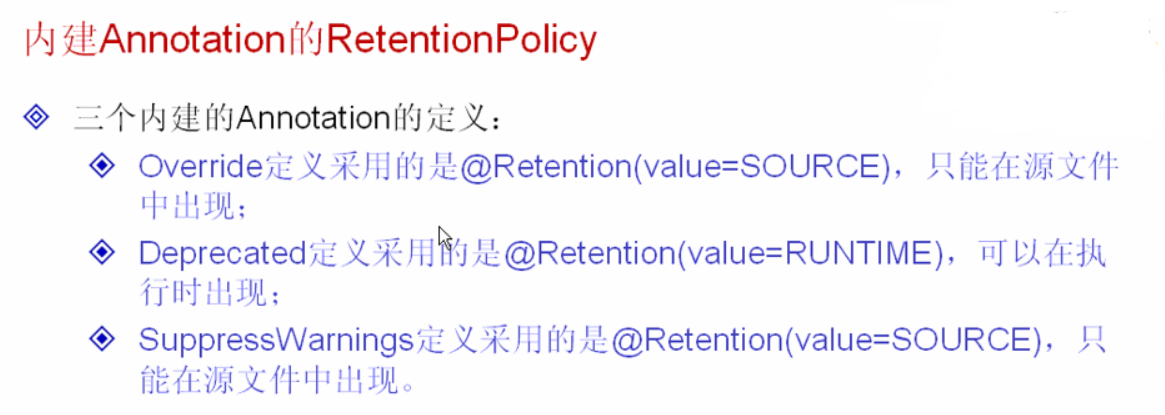1,可以通过反射取得使用的全部annotation
2,可以通过反射取得指定的annotation。
一个annotation要想变得有意义, 必须结合反射机制取得annotation中设置的全部内容。
以下是反射取得annotation相关方法:

如下:设置了三个annotation,那么此时,只有Deprecated的annotation的定义范围是RUNTIME的。
package 类集;
public class SimpleBeanOne{
@SuppressWarnings("unchecked")
@Deprecated
@Override
public String toString(){
return "Hello LiXingHua!!!" ;
}
};
复习:

因为只有Deprecated是RUNTIME定义范围,也就是执行时候出现。
那么通过反射的话只能取得一个。
取得annotation:
package 类集;
import java.lang.annotation.Annotation;
import java.lang.reflect.Method;
public class ReflectDemo01 {
public static void main(String args[]) throws Exception{ // 所有异常抛出
Class <?> c = null ;
c = Class.forName("类集.SimpleBeanOne") ;
Method toM = c.getMethod("toString") ; // 找到toString()方法
Annotation an[] = toM.getAnnotations() ; // 取得全部的Annotation
for(Annotation a:an){ // 使用 foreach输出
System.out.println(a) ;
}
}
}
输出结果:
@java.lang.Deprecated()
此时已经取得了一个annotation。
可以发现,上面是通过反射取得一个Method对象,然后通过这个Method对象获取这个方法所拥有的annotation。
以上操作代码实际上是通过三个系统内建的annotation完成的。那么也可以自定义annotation。
自定义一个注释annotation
package 类集;
import java.lang.annotation.Retention ;
import java.lang.annotation.RetentionPolicy ;//指定范围
@Retention(value=RetentionPolicy.RUNTIME) // 此Annotation在类执行时依然有效,注意,这个value值是RetentionPolicy的枚举值。
public @interface MyDefaultAnnotationReflect{
public String key() default "LXH" ;
public String value() default "李兴华" ;
}
以上annotation范围在执行时候有效,下面定义一个类使用此annotation。
package org.lxh.demo16.reflectannotation ;//指定范围。
public class SimpleBeanTwo{
@SuppressWarnings("unchecked")
@Deprecated
@Override
@MyDefaultAnnotationReflect(key="MLDN",value="www.mldnjava.cn")
public String toString(){
return "Hello LiXingHua!!!" ;
}
};
使用反射取得指定的annotation,因为现在唯一设置内容的就是MyDefaultAnnotationReflect
package 类集; import java.lang.reflect.Method; public class ReflectDemo02 { public static void main(String args[]) throws Exception{ // 所有异常抛出 Class <?> c = null ; c = Class.forName("类集.SimpleBeanTwo") ; Method toM = c.getMethod("toString") ; // 找到toString()方法 if(toM.isAnnotationPresent(MyDefaultAnnotationReflect.class)){ // 判断是否是指定的Annotation MyDefaultAnnotationReflect mda = null ; mda = toM.getAnnotation(MyDefaultAnnotationReflect.class) ; // 得到指定的Annotation String key = mda.key() ; // 取出设置的key String value = mda.value() ; // 取出设置的value System.out.println("key = " + key) ; System.out.println("value = " + value) ; } } }
输出:
key = MLDN
value = www.mldnjava.cn
上文发现,annotation可以通过key(),value()方法取得所设置的变量名和变量值。
annotation在实际中,不管如何使用,最终肯定是结合反射机制,也就是说可以通过annotation设置一些内容到方法上去,以完成特点功能。